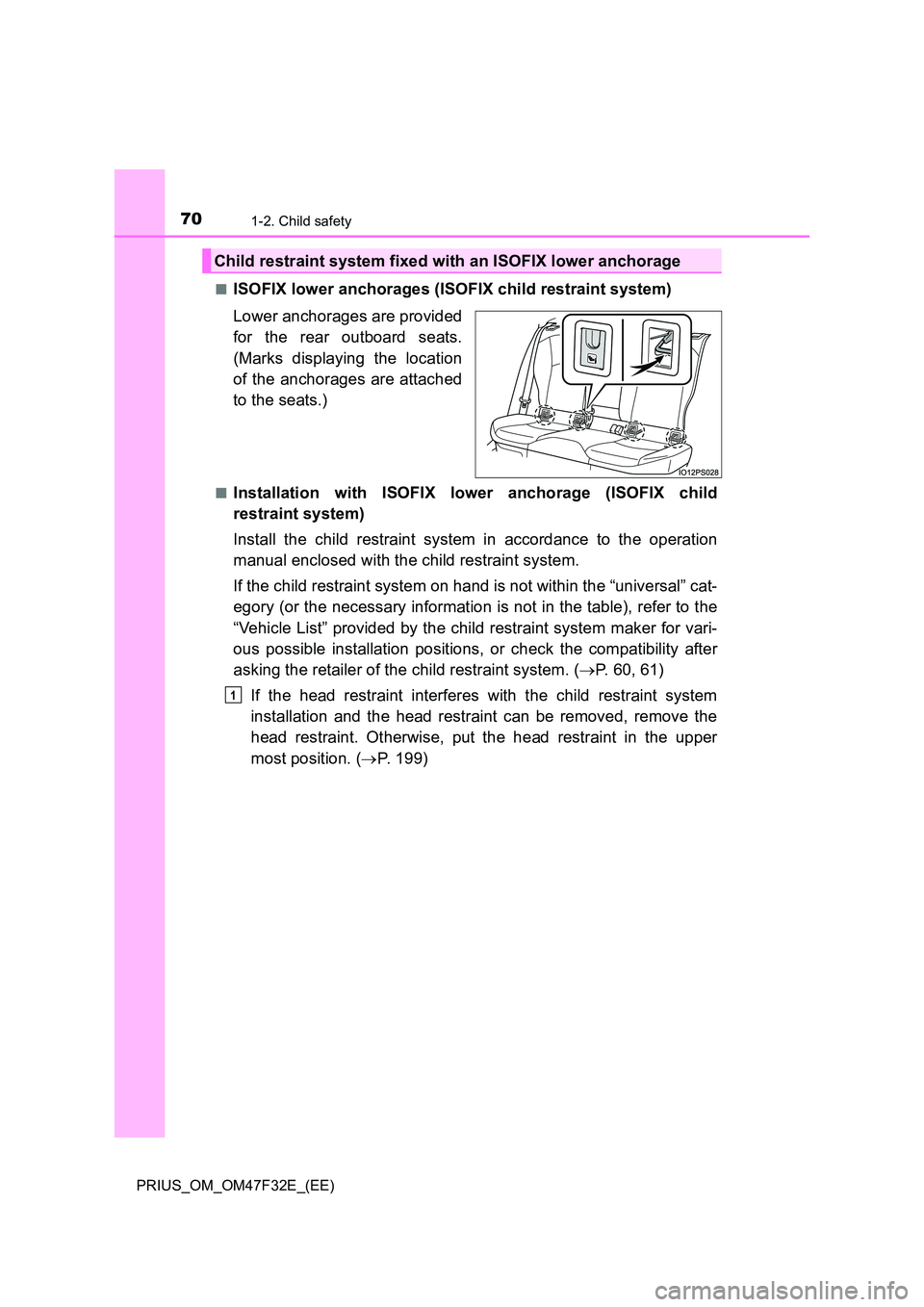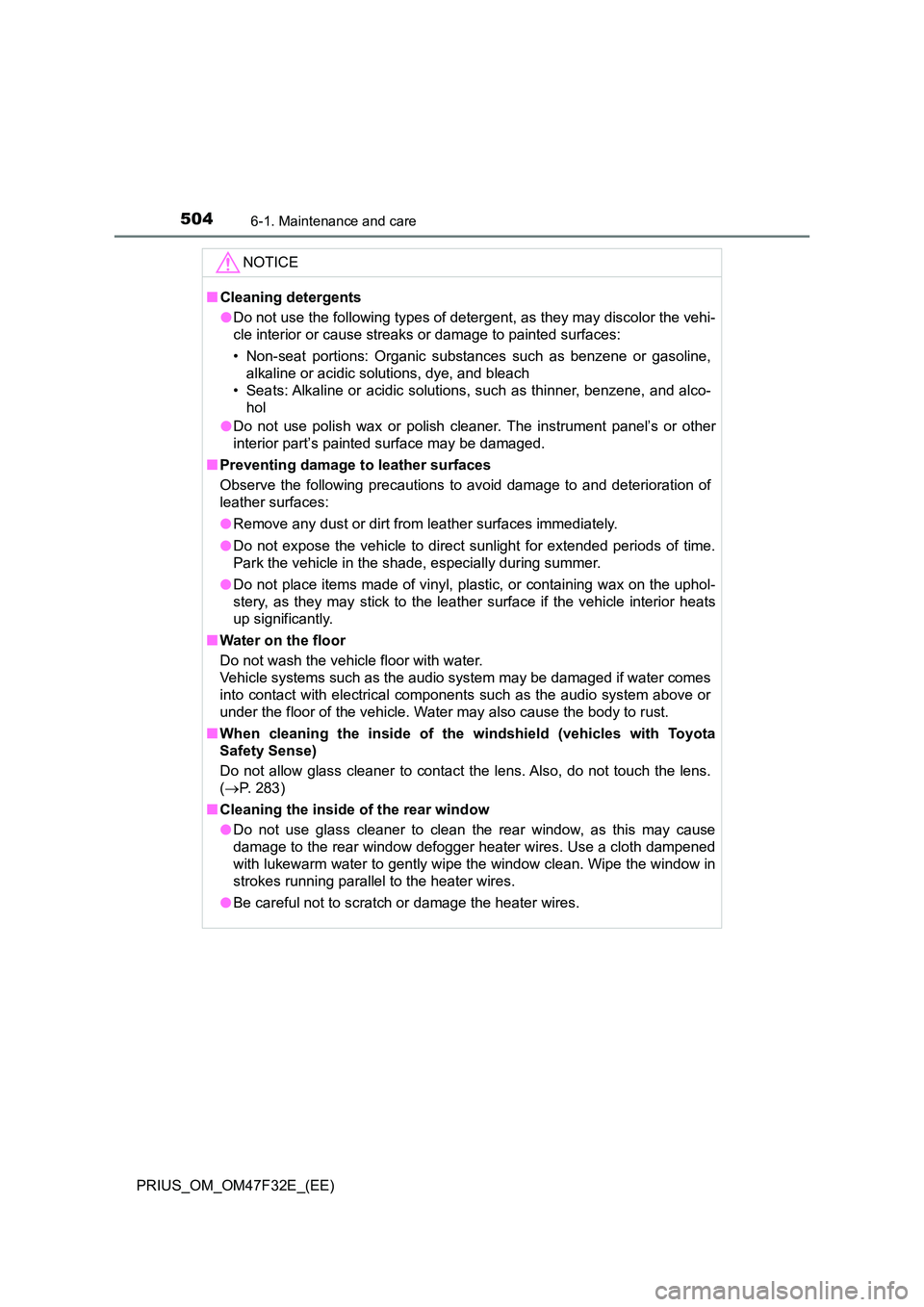Page 72 of 770

701-2. Child safety
PRIUS_OM_OM47F32E_(EE)
■ISOFIX lower anchorages (ISOFIX child restraint system)
Lower anchorages are provided
for the rear outboard seats.
(Marks displaying the location
of the anchorages are attached
to the seats.)
■Installation with ISOFIX lower anchorage (ISOFIX child
restraint system)
Install the child restraint system in accordance to the operation
manual enclosed with the child restraint system.
If the child restraint system on hand is not within the “universal” cat-
egory (or the necessary information is not in the table), refer to the
“Vehicle List” provided by the child restraint system maker for vari-
ous possible installation positions, or check the compatibility after
asking the retailer of the child restraint system. ( P. 60, 61)
If the head restraint interferes with the child restraint system
installation and the head restraint can be removed, remove the
head restraint. Otherwise, put the head restraint in the upper
most position. ( P. 199)
Child restraint system fixed with an ISOFIX lower anchorage
1
Page 74 of 770
721-2. Child safety
PRIUS_OM_OM47F32E_(EE)
■Top tether anchorages
Top tether anchorages are pro-
vided for the outboard rear
seats.
Use top tether anchorages
when fixing the top strap.
■Fixing the top strap to the top tether anchorage
Install the child restraint system in accordance to the operation
manual enclosed with the child restraint system.
Adjust the head restraint to
the upmost position.
If the head restraint interferes
with the child restraint system or
top strap installation and the
head restraint can be removed,
remove the head restraint.
( P. 200)
Latch the hook onto the top
tether anchorage and tighten
the top strap.
Make sure the top strap is
securely latched. ( P. 69)
When installing the child
restraint system with the head
restraint being raised, be sure to
have the top strap pass under-
neath the head restraint.
Using a top tether anchorage
Top tether anchorages
Top strap
1
Hook
Top strap 2
Page 84 of 770

821-4. Hybrid system
PRIUS_OM_OM47F32E_(EE)
■ After the 12-volt battery has discharged or when the terminal has been
removed and installed during exchange, etc.
The gasoline engine may not stop even if the vehicle is being driven by the
hybrid battery (traction battery). If this continues for a few days, contact any
authorized Toyota retailer or Toyota authorized repairer, or any reliable
repairer.
■ Sounds and vibrations specific to a hybrid vehicle
There may be no engine sound or vibration even though the vehicle is able to
move with the “READY” indicator is illuminated. For safety, apply the parking
brake and make sure to shift the shift position to P when parked.
The following sounds or vibrations may occur when the hybrid system is
operating and are not a malfunction:
● Motor sounds may be heard from the engine compartment.
● Sounds may be heard from the hybrid battery (traction battery) under the
rear seats when the hybrid system starts or stops.
● Relay operating sounds such as a snap or soft clank will be emitted from the
hybrid battery (traction battery), under the rear seats, when the hybrid sys-
tem is started or stopped.
● Sounds from the hybrid system may be heard when the back door is open.
● Sounds may be heard from the transmission when the gasoline engine
starts or stops, when driving at low speeds, or during idling.
● Engine sounds may be heard when accelerating sharply.
● Sounds may be heard due to regenerative braking when the brake pedal is
depressed or as the accelerator pedal is released.
● Vibration may be felt when the gasoline engine starts or stops.
● Cooling fan sounds may be heard from the air intake vent. (P. 85)
■ Vehicle proximity notification system
In the following cases, the vehicle proximity notification system may be diffi-
cult for surrounding people to hear.
● In very noisy areas
● In the wind or the rain
Also, as the vehicle proximity notification system is installed on the front of
the vehicle, it may be more difficult to hear from the rear of the vehicle com-
pared to the front.
■ When “Proximity Notification System Malfunction Visit Your Dealer” is
displayed on the multi-information display
The vehicle proximity notification system may be malfunctioning. Have the
vehicle inspected by any authorized Toyota retailer or Toyota authorized
repairer, or any reliable repairer.
Page 202 of 770
2003-3. Adjusting the seats
PRIUS_OM_OM47F32E_(EE)
■Removing the head restraints
Front and rear center seats
Rear outboard seats
Pull the head restraint up while pressing
the lock release button.
Pull the seatback lock release lever and
fold down the seatback until it reaches
the position where the head restraints
can be removed.
Pull the head restraint up while pressing
the lock release button.
Lock release button
1
2
Lock release
button
Page 204 of 770
2023-3. Adjusting the seats
PRIUS_OM_OM47F32E_(EE)
WARNING
■Head restraint precautions
Observe the following precautions regarding the head restraints. Failure to
do so may result in death or serious injury.
● Use the head restraints designed for each respective seat.
● Adjust the head restraints to the correct position at all times.
● After adjusting the head restraints, push down on them and make sure
they are locked in position.
● Do not drive with the head restraints removed.
Page 506 of 770

5046-1. Maintenance and care
PRIUS_OM_OM47F32E_(EE)
NOTICE
■Cleaning detergents
● Do not use the following types of detergent, as they may discolor the vehi-
cle interior or cause streaks or damage to painted surfaces:
• Non-seat portions: Organic substances such as benzene or gasoline,
alkaline or acidic solutions, dye, and bleach
• Seats: Alkaline or acidic solutions, such as thinner, benzene, and alco-
hol
● Do not use polish wax or polish cleaner. The instrument panel’s or other
interior part’s painted surface may be damaged.
■ Preventing damage to leather surfaces
Observe the following precautions to avoid damage to and deterioration of
leather surfaces:
● Remove any dust or dirt from leather surfaces immediately.
● Do not expose the vehicle to direct sunlight for extended periods of time.
Park the vehicle in the shade, especially during summer.
● Do not place items made of vinyl, plastic, or containing wax on the uphol-
stery, as they may stick to the leather surface if the vehicle interior heats
up significantly.
■ Water on the floor
Do not wash the vehicle floor with water.
Vehicle systems such as the audio system may be damaged if water comes
into contact with electrical components such as the audio system above or
under the floor of the vehicle. Water may also cause the body to rust.
■ When cleaning the inside of the windshield (vehicles with Toyota
Safety Sense)
Do not allow glass cleaner to contact the lens. Also, do not touch the lens.
( P. 2 8 3 )
■ Cleaning the inside of the rear window
● Do not use glass cleaner to clean the rear window, as this may cause
damage to the rear window defogger heater wires. Use a cloth dampened
with lukewarm water to gently wipe the window clean. Wipe the window in
strokes running parallel to the heater wires.
● Be careful not to scratch or damage the heater wires.